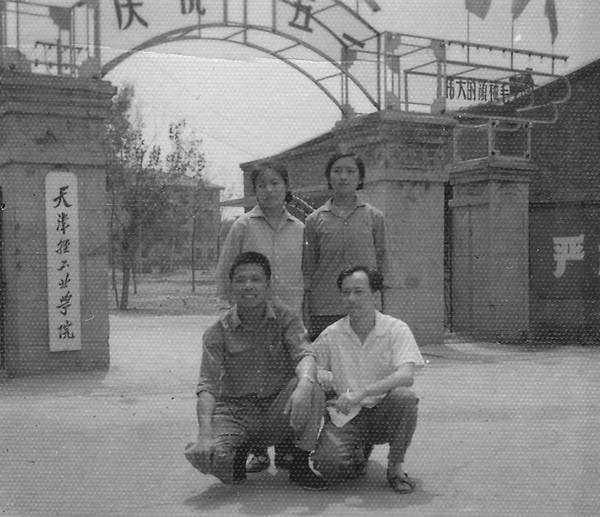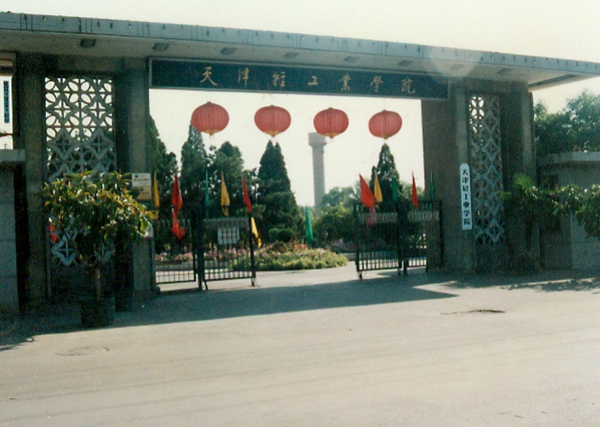All Begins with “a Skewed Gate along a Crooked Street”
2016-12-06
Initially, our main gate found itself to the east of Donghuayuan Neighborhood, facing the narrow alley that links Wuer Xincunlu to Dagu Nanlu. And south to the gate was a small room of the gatekeepers. It was very inconvenient to walk in and out of the school through it, so it was moved to the end of the road lying east to the present main teaching building to face Dagu Nanlu. Although this east-lying road stretches from due north to due south, the gate subjected to Dagu Nanlu to go from northwest to southeast on the grounds that Dagu Nanlu which parallels Haihe River follows the River to go from northwest to southeast. That is why the gate was nicknamed as “a Skewed Gate along a Crooked Street” . The third move of the gate happened when the center of the main teaching building was transformed into a circular square, so it was moved across some distance to the northwest to get both the gate and the north-south main road look right into the square center. Hence, the gate got upright, and so did the main road. About half a century witnessed the three relocations of the gate.
The Most Impressive Is “the Skewed Gate along a Crooked Street”.
Lin Kairong, born in 1925, is 86 years old this year. Before retirement, he once served as the Deputy Director of the Teaching Affairs Office, Vice-president, etc. In 1956, Lin Kairong followed the adjustment of majors to find himself work in Tianjin University as a secretary of paper-making from Sichuan Institute of Chemical Technology. After the establishment of Hebei Institute of Light Industry in 1958, the major of paper-making of Tianjin University experienced two “divisions”. The first happened in 1959 when the teaching staff of paper-making of Tianjin University were divided into two groups by the National Ministry of Light Industry to meet the wish of Hebei Institute of Light Industry during which he was asked to stay in Tianjin University. The second happened in 1971 when during the “Cultural Revolution” all the paper-making teaching staff of Tianjin University of paper-making joined Hebei Institute of Light Industry, and Lin was one of them.
Mr. Lin recalls, “After I transferred to work here, I was still living for some time at Tianjin University. And every day a single-journey commuting between where I worked and where I dwelled took 30 to 40 minutes. The then road was not so spacious and smooth as it is now, and it was all dirt and potholes, so riding a bike was particularly difficult. I didn’t move to the present residence until 1980. ” And his memory concerning the University is all about “the skewed gate along a crooked street”. He continues, “Our university is situated beside Dagu Nanlu which runs crooked to follow Haihe River, so our gate is crooked to match the street. Although on campus our roads are all vertical or horizontal, they are leaning to one side in relation to Dagu Nanlu. Therefore, at that time, ‘the skewed gate along a crooked street’ is a hardnut for us to to crack. Our current gate is different; it is an enlarged one with a broad view, and it is very nice to have the question answered.”

A Gate of Two Lampposts Tied with a Straw Rope
Born in 1937, Wang Yiyun was endowed with simplicity and dedication common among their generation. In 1954 he was admitted to study at Tianjin Paper Industry School then. After his 1958 graduation, he stayed to work for the school Communist Youth League, and later was transferred to the laboratory where he had since been working hard until his retirement in 1992. Speaking of the school in his day, Wang Yiyun told our reporter, “At that time, the gate was made with two lampposts tied with a straw rope, and the main teaching building used to be a big puddle on which some students even did their boating. Near Huayuan Lou were grapes, with which we would be treated on the Mid-autumn Day.” All people were getting along with each other harmoniously although the conditions were very harsh. Wang Yiyun was one of the first batch of three class students enrolled in Tianjin then. “There are five North Korean students in our class, and we have planted a Sino-Korean Friendship Tree even!” In his recollections, all people helped with the socialist construction be they workers or students. Both teachers and students plunged into labor and study all the time. And Building No.1, a four-storeyed building, is a joint project accomplished by teachers and students who helped by fetching bricks during its construction.
A Gate Pieced Together with Mud and Two Painted Poles
The 74-year-old Chen Yunjun, who used to be an associate professor of the Department of Basic Subjects, came from Shanghai in 1958 to teach until retirement. According to Professor Chen, at the beginning, our school was home only to three departments: the Chemistry Department, the Foodstuff Department and the Machinery Department to offer seven majors, namely, Pulp and Paper-making, Silicate, Grease, Foodstuff, Fermentation, Food Machinery and Paper-making Machinery. Students of all types were more than 1,700. There were four school-run factories: a winery, a machine factory, a riboflavin factory and a paper mill. At that time, the few buildings plus poor conditions could barely meet the then demands, so the situation was very bleak.

Professor Chen told us memories of his first meeting with this school: Following the receptionist of the Personnel Department to have walked the school for some time, he failed to locate the school gate. When he posed his puzzle to the receptionist, he was told, “We have already walked past it.”
It turned out that the school gate then was two clumsily painted poles covered with mud whose name plate is still on the wall of Building No. 1. At that time the school was very shabby with a couple of buildings scattered here and there, that is, the present Building No. 1, and its two opposite counterparts (now Buildings No. 8, and No. 9), Building No. 10 which used to be a small dining hall, a large dining hall to the west and a three-storeyed dorm building near the main road which is a bank now. All teachers were living in Building No. 9 where one crowded room were shared by 70 to 80 individuals. So the living conditions were more uncomfortable than the high school from which Chen had graduated. This poor scene frustrated Chen who came from Shanghai East China Normal University.
In professor Chen’s memory, the students complained a lot about the school environment and its teaching conditions the first day of their class. To handle this, teachers not only taught, but also worked part-time as their class teacher to talk students into being at ease with whatever they had. Fortunately, under the context of the whole country showing great enthusiasm for socialist development, inspired by the then “Great Leap Forward” movement, such young teachers from all corners of the country as Chen were highly encouraged and confident in accomplishing their ideal at this newly established institution with great potential. So, they were looking forward to its bright prospects in its near future.
Editor’s Note: Teachers and students at TUST have together experienced every step of its development starting from “the skewed gate along a crooked street” to the construction of buildings with their own hands. This is TUST of our own, a home produced by every single Tuster.


